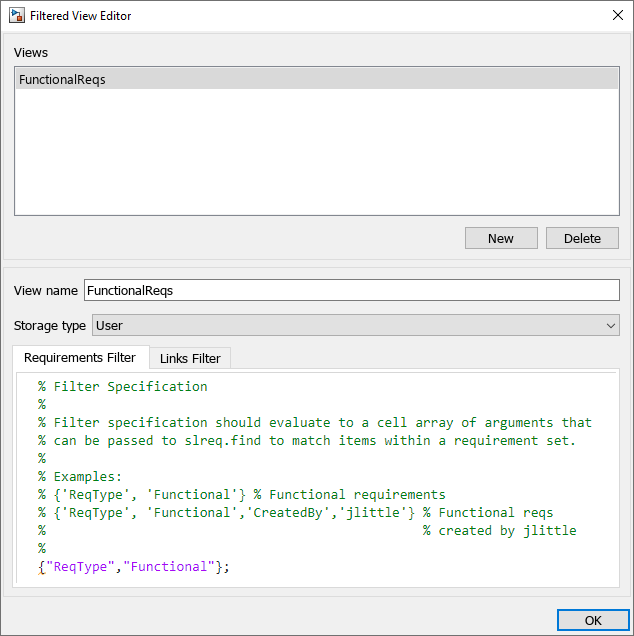在需求编辑器中配置视图
您可以通过创建基于需求和链接元数据进行过滤的视图来选择在需求编辑器和需求视角中显示哪些需求和链接。您还可以通过配置软件在视图中保存的显示列来选择要显示哪些需求属性和自定义属性。您可以使用 MAT 文件或内部存储了视图的需求集与其他用户共享视图。
创建视图
要创建视图,请执行以下操作:
打开过滤视图编辑器:
在需求编辑器中,选择过滤视图
 > 管理视图。
> 管理视图。在需求视角中,点击选择视图菜单并选择管理视图。
在过滤视图编辑器中,点击新建。在视图名称字段中输入名称。
要将视图存储在预设项文件夹中,请将存储类型设置为用户。有关详细信息,请参阅MATLAB 存储设置的位置。要将视图存储在需求集,请从存储类型旁边的列表中选择需求集。您不能将视图存储在链接集中。
注意
当您将视图存储在需求集时,对视图的更改不会导致需求集有未保存的更改。
在需求过滤器和链接过滤器选项卡中,定义您的过滤准则,然后点击确定。如果您在需求集存储了视图,请保存该需求集。
当您应用视图然后在需求编辑器中添加和删除列时,Requirements Toolbox™ 会保存视图中的列布局。有关详细信息,请参阅应用视图。
或者,您可以将当前列布局和应用的过滤器保存为新视图:
在需求编辑器中,选择过滤视图
 > 保存视图。
> 保存视图。在需求视角中,点击选择视图菜单并选择保存视图。
在保存视图对话框中,输入视图的名称,然后点击确定。您还可以通过从列表中选择现有视图来覆盖它。
通过编程创建视图
要以编程方式创建视图,请使用 create 函数。
定义需求和链接过滤器
要在过滤视图编辑器中定义过滤准则,请输入一个以逗号分隔的名称-值参量元胞数组,其输入语法与 slreq.find 相同。例如,要仅显示 Type 设置为 Functional 的需求,请使用此过滤器:
{"ReqType","Functional"};
提示
要定义一个过滤器来显示至少满足多个指定条件中的一个条件的对象,请用 "-or" 分隔指定的条件。例如,要显示将 Type 设置为 Functional 或将 Type 设置为 Informational 的需求,请使用以下过滤器:
{"ReqType","Functional","-or","ReqType","Informational"};需求过滤器适用于所有已加载的需求、引用需求和申述。链接过滤器适用于所有加载的链接。
通过编程定义过滤器
要以编程方式定义过滤器,请设置 slreq.View 对象的 ReqFilter 和 LinkFilter 属性。以字符串标量或字符数组的形式输入过滤器,其中包含以逗号分隔的名称-值参量的元胞数组,其输入语法与 slreq.find 相同。
例如,考虑将 slreq.View 对象分配给名为 myView 的变量。要仅显示 Type 设置为 Functional 的需求,请输入:
myView.ReqFilter = "{'ReqType','Functional'};";应用视图
要在需求编辑器中应用视图,点击过滤视图  ,然后从列表中选择一个视图。要将视图重置为默认视图,请选择默认视图。
,然后从列表中选择一个视图。要将视图重置为默认视图,请选择默认视图。
要在需求视角中应用视图,点击选择视图菜单并从列表中选择一个视图。
当您在需求编辑器中添加和删除列时,Requirements Toolbox 会保存视图中的列布局。有关添加和删除列的更多信息,请参阅 显示额外的列。
以编程方式应用视图
要以编程方式应用视图,请使用 activate。要将视图重置为默认视图,请使用 activateDefaultView。
管理视图
要编辑或删除视图,请打开过滤视图编辑器:
在需求编辑器中,选择过滤视图
 > 管理视图。
> 管理视图。在需求视角中,点击选择视图菜单并选择管理视图。
要编辑视图,请选择该视图并编辑名称或过滤准则。您不能编辑存储位置。
要删除视图,请选择该视图并点击删除。
通过编程方式管理视图
要以编程方式编辑视图,请编辑 slreq.View 对象的 Name、ReqFilter 或 LinkFilter 属性。
要以编程方式删除视图,请使用 delete。
共享视图
要与其他用户共享视图,您可以共享:
集合中存储了视图的需求集
用户预设项 MAT 文件
Requirements Toolbox 视图设置 MAT 文件
要共享存储在需求集的视图,请共享 SLREQX 文件。
要共享存储在首预设项文件夹中的视图,请使用 prefdir 确定首预设项文件夹的位置。有关详细信息,请参阅MATLAB 存储设置的位置。共享名为 slreqViewSettings_v2.mat 的 MAT 文件。其他用户可以将此文件放在他们的预设项文件夹中以使用视图。
要将 Requirements Toolbox 视图设置共享为 MAT 文件,请使用 slreq.exportViewSettings 导出当前加载的视图。要导入 MAT 文件,请使用 slreq.importViewSettings。视图保存在它们最初存储的位置。